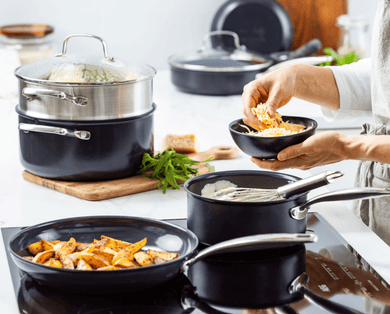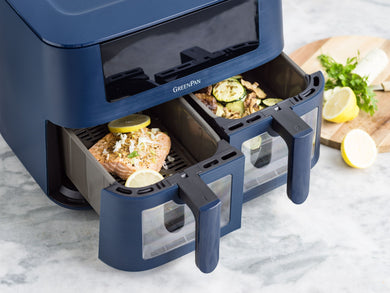
¡Buen Provecho! - How To Cook Authentic Mexican Food At Home
Mexican food has been a part of the Australian culinary landscape for many years. Take a seat at any cafe or trendy restaurant, and you’re almost guaranteed to find a taco, burrito or enchilada lurking somewhere on the menu. The late Saturday night - or, perhaps more accurately, early Sunday morning - stagger up to the welcoming window of a burrito van has similarly become an indispensable part of Aussie youth culture.
In the past decade or so,, fast food chains such as Taco Bell, Guzman Y Gomez & Zambrero have been popping up around the country, further entrenching Mexican-inspired cuisine into the local zeitgeist.
While this addition to the Australian dining scene is most welcome, anyone who has visited Mexico, or for that matter, anywhere in the southern USA, will be acutely aware of one very uncomfortable truth: Mexican food in Australia is—to put it delicately—not exactly fair dinkum. Or, as the locals on the other side of the Pacific say, “No es neta.”
To be fair, in recent years, numerous high-quality Mexican restaurants have emerged - particularly in Melbourne and Sydney. However, for the overwhelming majority of Australians, the Mexican food to which we have regular access is kind of the culinary equivalent of Speedy Gonzales or the quintessential image of the bushy-moustached, oversized-sombrero-wearing, guitar-strumming Mariachi singer: A cartoonish parody of the real thing. Andele, andele!
The dilemma here is that while your post-clubbing burrito may hit the spot, most Aussies have no idea what they’re missing out on. Authentic Mexican food has depth, complexity and variety that most of us have never experienced. That’s why, after our delectable journey through the art of Korean cooking, the next stop on our Global Cuisine Blog series will teach you how to cook authentic Mexican food at home. Short of jumping on the next flight to Guadalajara, it’s the best way to enjoy the incredible flavours, colours and textures of Mexico in your own dining room.
Basic Mexican Flavours
Astute observers of the options on offer in this part of the world could be excused for thinking that all Mexican food is essentially made from the same handful of ingredients. It’s a fair conclusion to draw, given that whether you’re munching on a taco, scoffing a burrito or chewing on an enchilada, it seems like it’s just beans, meat, cheese, avocado and tomatoes in various formats and combinations with a dash of hot sauce thrown in for good measure. True Mexican food is way more intricate than this, featuring a rich abundance of fresh produce and bright flavours. Let’s take a look beneath the hood and see what makes real Mexican food run.
1. Corn Tortillas
While not strictly speaking an “ingredient”, tortillas are so central to Mexican gastronomic life that they demand a prominent mention. For most native Mexicans, the sound and smell of their mothers cooking fresh, soft corn tortillas every morning is the defining childhood memory. The critical words here are “corn” and “soft”. Indigenous Mexicans are known as “The People of the Corn” for good reason. Corn (known as maize before harvesting) is so deeply ingrained in the Mexican psyche that it has become an intrinsic part of life and culture. However, we’re not talking about Doritos here! The distinctive smell and flavour of authentic soft corn tortillas is a central element of virtually every Mexican meal. Tortillas require only three ingredients: Masa Harina (masa corn flour - available at many local supermarkets), water and a spattering of salt. They are relatively quick and easy to make on the stovetop using a regular non-stick skillet. Try out this simple corn tortilla recipe, and you’re well on your way to a real Mexican feast.
Tortillas are traditionally eaten as an accompaniment but also form an integral part of many dishes, such as soft tacos and quesadillas. Sometimes, they can steal the show when they take centre stage in delectable favourites such as Tortilla Soup.
2. Garlic & Onions
These staples are an essential part of virtually every Mexican dish. Most recipes call for white onions. However, in Australia, these tend to be somewhat more pungent than their sweeter Central American cousins. For a more faithful approximation of the real thing, substitute red onions or soak your local white onions in water for an hour or two before using them to remove some of the sharpness and bitterness. For garlic, your best bet is to choose locally grown produce, easily distinguishable by the roots still attached to the bottom. It is more flavourful and usually contains fewer pesticides than imported items.
3. Cumin
This spice delivers the signature earthy, wholesome tones that make Mexican cuisine the perfect comfort food. It’s readily available in ground form on supermarket shelves. However, try toasting a handful of cumin seeds in a sturdy frying pan, then crushing them with a mortar and pestle or blitzing them in a food processor for a more mouthwateringly irresistible flavour. The incredible aromas will blow you away and infuse your food with the next level of deliciousness.
4. Herbs
Fresh herbs are another must if you want to wow your family and friends. While you can opt for dried herbs in a pinch, there is simply no substitute for fresh herbs. They’re a little bit more effort, but the vibrant, succulent flavours make the difference between good and great. Fortunately, Mexican cuisine keeps it relatively simple by relying on three main varieties.
a) Oregano
Mexican oregano is another essential and ubiquitous ingredient. While sharing a similar basic flavour profile to its Italian counterpart, Mexican oregano grows native throughout Central and South America. It boasts a bolder, more distinctive flavour with strong undertones of citrus and a hint of licorice. While this gorgeous herb is not always readily available, you can find it online pretty easily, so take the plunge, and you won’t regret it once you add it to your food.
b) Coriander/Cilantro
Australia, we need to talk. We get it; some of us are genetically predisposed to hate coriander, while others have simply never acquired a taste for it. However, if you’re serious about embarking on your journey through the glorious world of Mexican cooking, you’re just going to have to suck it up. The good news is that with repeated exposure, most of us can develop a liking for this bold herb, so pull up your big boy/girl pants and add it to your meals if you want to experience the real deal. A word of warning: coriander powder is made from dried coriander seeds and tastes nothing like the herb. However, coriander powder can pair beautifully with Mexican food, so don’t stress if you put it in your recipe. Just don’t forget the green stuff s well!
c) Epazote
This unique herb is unique to Mexico and parts of Central and South America. It is a crucial ingredient in authentic refried beans and has a pungent, rustic, aniseedy flavour that is distinctively Mexican. It’s extremely difficult to find in Australia, so don’t stress if you can’t get your hands on any. However, its central place in Mexican cuisine makes it worthy of a mention here, if only for educational purposes. If you can find Epazote by some miracle, it will upgrade your Mexican cooking game.
5. Adobo Seasoning
This spice mix is another instantly recognisable element in true Mexican meals. It’s an all-purpose seasoning primarily used as a rub or in marinades for meat, chicken and fish dishes, but can also be used to brilliant effect with vegan or vegetarian dishes. If you can’t find adobo seasoning at your local shops, it’s simple enough to make at home using some common ingredients:
- Garlic powder
- Oregano (Mexican, if you can find it. Otherwise, regular oregano will do)
- Kosher salt
- Black pepper
- Turmeric
If you want to add a bit of a smoky, spicy twist, throw in a generous pinch of chipotle powder. You won’t regret it.
6. Adobo Sauce
Not to be confused with its seasoning partner above, adobo is the signature red sauce with the deep, powerful flavour that you frequently find liberally slathered on classical Mexican dishes such as enchiladas and adobo chicken. The good news is that adobo sauce is usually pretty easy to find in Australia, so keep an eye out in the international food section of your supermarket, and you’re likely to stumble across a can. You’ll often find it infused with chipotle chilli, which gives it a smoky, earthy accent.
7. The Spice of Life - Chillis
Chillis are synonymous with Mexican cooking and are found in a huge range of local specialties. Most of us are familiar with the widely used jalapenos (please, for the love of all things holy, it’s pronounced “Halapenyo”, not Jallapeeno, you gringo!), but you can feel free to experiment with any variety based on your preference for heat and flavour. While fresh chilli is always delicious, chilli powders are integral to many Mexican recipes. For the spice lovers, Cayenne powder provides a serious hit of spice. For the more pain-averse, ancho chilli powder is a milder option with a gloriously fruity flavour, making it one of the most widely used ingredients south of the border.
8. A Touch of Zest - Lime
Let’s be VERY clear here: Lime is used in Mexican food, and lemon is NOT an acceptable substitute if you want to achieve an authentic flavour profile. To be honest you can barely even find a lemon in Mexico if you try. Lime is the zesty counterpoint to the mostly earthly, savoury flavours and typically brings everything together with its tangy burst of citrusy goodness.
Authentic Mexican Dishes You Can Cook At Home
In our first instalment of the Global Cuisine series, we did a deep dive into cooking Korean food at home and delved into some staple dishes. However, most of you are probably more familiar with the main cast of characters in the Mexican repertoire. Rather than cover familiar ground, we’ll introduce some lesser-known but quintessentially Mexican dishes you can experiment with in your kitchen and wow the crowd with your newfound skills.
1) Mole (Pron. Moh-Lay)
Technically, mole is a sauce rather than a dish. However, you can simmer pretty much anything your heart fancies in this magnificent sauce to achieve a truly unique dish that is at once familiar and delectably different.
Mole is essentially a chilli sauce, but in practice, it is so much more. The secret ingredient that makes mole so unique is cocoa. You read that right! Cocoa adds a rich and slightly bittersweet depth that sets it completely apart from everything you know about Mexican food.
Mole is incredibly versatile, and you’ll commonly find it elevating chicken, beef, pulled pork or whatever vegetables you like (potatoes, rice and black beans are a superb combo) to leyenda (legend) status. If you’re short on time, it’s acceptable to simmer your preferred ingredients in a large skillet or saucepan to keep the flavours in. However, for best results, this is the perfect opportunity to bring your non-stick slow cooker off the bench and into the fray. Slow-cooking your ingredients in mole sauce is the perfect way to infuse them with superb flavours and ensure you have the most tender, melt-in-your-mouth experience.
2) Pozole
Is it a stew? Is it a soup? Well, it’s kinda both! Pozole is a staple in any Mexican kitchen and a comforting favourite when dining out. Traditional pozoles contain hominy, a deliciously chewy version of whole corn kernels rarely available in Australia. If you can find some canned hominy (try online or specialty stores for the best chances), then you should definitely jump at the chance. Otherwise, you can proceed without it or substitute regular corn kernels. They won’t taste the same, but will still be yummy.
If you’ve read through the list of key ingredients above, you will be well served, as they are all included in most Pozole recipes. However, a simple online search will show an incredible variety of recipes. We are particularly fond of this spectacular Shredded Chicken Pozole Verde recipe. The green colour comes partly from tomatillos, which are everywhere you look in Mexico and the US, although less common in these parts. Don’t stress, however! You can substitute green tomatoes, yellow tomatoes or even gooseberries (in fact, gooseberries are best) and achieve much the same results.
Fun fact: Pozole might be one of the oldest recipes still used today. This ancient dish dates back to the Aztecs, who added the flesh of human sacrifices to broth. These days, the core recipe remains much the same, just without the need for human “volunteers”. After all, chicken, pork, and vegetables are far less complicated!
3) Carne Asada/Pollo Asada
For meat lovers, this is definitely your go-to! We love a good barbie here in Oz, so next time you fire up the grill, you might want to blow the froth off a couple of Coronas and give Carne Asada (beef) or Pollo Asado (chicken) a try. The key is to marinate the meat beforehand (no less than 2 hours, no more tha 8) to allow the flavours to permeate. A typical Asada marinade contains beer, soy sauce, lime juice, orange juice and seasonings of choice. The divine combination also helps to achieve a glorious, crispy exterior while preserving a moist, tender interior. It’s no wonder Asada is one of the most popular dishes inside and outside of Mexico. Carne Asada/Pollo Asado is perfect on its own, or you can slice or shred it and make it into tacos for a breathtaking culinary experience. For a meat-free option, try this marinade out with tofu steaks and you will be in Mexican heaven. Tofu sucks in flavours rapidly, so you can reduce the marinating time to around 1-2 hours maximum.
4) Calabacitas
If vegan fare is more your speed, this deceptively simple dish will provide you with all the satisfying Mexican flavours without the animal flesh. For a country that really loves its meat, Mexicans sure know how to do vegetables in ways that will leave you feeling like you’re missing nothing. This dish is a perfect example of that. Think of Calabacitas kind of like a Mexican ratatouille. It’s typically made with zucchini, but you can adapt it to use eggplant or any other squash you prefer. For best results, roast fresh tomatoes, onions and garlic in the oven before cooking the remaining ingredients in a top-quality stock pot until the vegetables are lovely and soft but not mushy. Like Pozole above, hominy goes perfectly in this recipe, but some regular corn kernels will do the job just as well if you can't get your hands on any.
5) Migas
If you’re bored of the standard breakfast fare, you are in for a serious treat with this one. You may not have heard of migas before, but it’s common at breakfast tables in homes across Mexico. The word Migas literally means “crumbs”, and this dish gets its name from the fact that it uses leftover corn tortillas toasted and broken up, then cooked into fragrantly spiced scrambled eggs with onions and tomatoes and served with a side of black beans or refried beans. Migas is incredibly simple to make and is a delightfully different and spectacularly tasty way to start your day or enjoy a special Sunday brunch.
Additional Resources
We’ve barely touched the surface of Mexican food above, but we hope that all this has whetted your appetite to learn more and try your hand at cooking it at home.
Whether you’re interested in the dishes above or more familiar fare such as salsas, guacamole, tacos, enchiladas and the like, there are reams of information online. However, it can be confusing to know where to start, so here are a few resources that we think really stand out:
- Mexican Please - A great site with tons of brilliant recipes that are easy to follow and typically simple to make.
- Mexico In My Kitchen - As authentic as it gets, with an impressive list of homestyle Mexican recipes that you won’t find on most cooking sites.
- Isabel Eats - A gorgeous range of classic, crowd-pleasing Mexican and Tex-Mex fusion recipes.
- Mexican Food Journal - Join a professional chef who spent 20 years living and developing his skills in Mexico.
We hope you’ve enjoyed this brief expedition into the world of Mexican cooking and that it’s helped you discover the extraordinary variety and complexity of Mexican cuisine. With a few choice ingredients, some inspiration, and, of course, some excellent non-toxic and non-stick cookware, you can move past the standard fare and create exciting and authentic Mexican feasts at home.
Has this article has got you reaching for your sombrero and shouting “Arriba, Arriba!”, on your way to the kitchen to whip up some spectacular Mexican creations? If so, there’s a great chance you’ll find more culinary inspo on our website. Head over to the GreenPan Recipe Section for a huge range of mouthwatering menu ideas, or our Non-Stick, Non-Toxic Cookware Blog for fascinating, entertaining and informative insights into everything cookware related.
¡Buen Provecho! (Enjoy your meal!)






